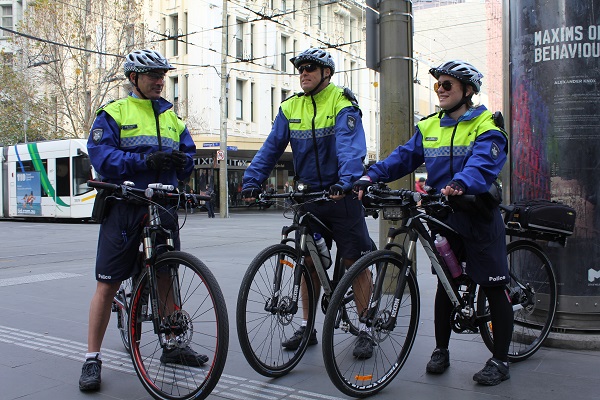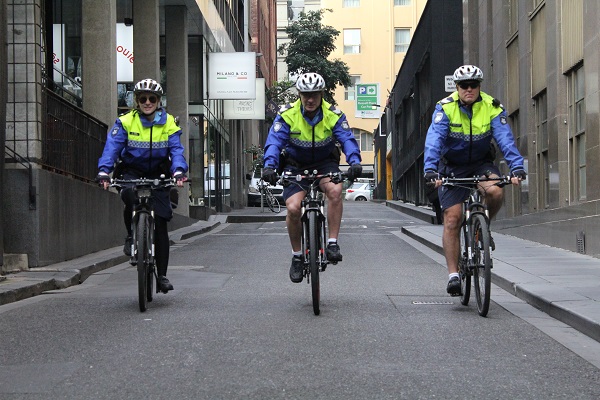Victoria Police’s Bicycle Patrol is focussed on keeping cyclists and all other road users safe, discovers Melissa Heagney.

It’s a cold Monday morning in Melbourne and members of Victoria’s State Bicycle Operations team are out on patrol.
State Bicycle Operations Co-ordinator Sergeant Arty Lavos, Melbourne Bicycle Patrol’s Acting Sergeant Justin Smith and First Constable Lauren Kane are keeping an eye on road users—drivers, bike riders and pedestrians—in Bourke Street Mall.
Peak hour is almost over and a mix of tourists, holiday makers and bargain hunters pass by, curious at the police officers on their mountain bikes.
As the officers scan the traffic, a man excitedly approaches them. He wants to show off his new bike, which he proudly explains, he found in the hard waste left on the side of the road near his home.
Not only did he score the bike, he says, he found a helmet to go with it.
“It’s a good find because you don’t usually find the helmet,” he says with a smile.
After a short but happy conversation the man hurries off, keen to ride his ‘diamond from the rough’ to his next destination.
Encounters like this, explains Sergeant Lavos, are not uncommon. In fact, the “Bicycle Patrol,” is seen as friendly and approachable.
“Approachability is number one when we’re doing our job—even though we’ve got all our equipment (handcuffs, etc.) we’re still really approachable and that’s the good thing about it,” Sergeant Lavos explains.
“You’re liaising with people all the time and letting people know we (police) are human and we can discuss family and things like that—it’s really important.”
He says being able to communicate with the community is the key to understanding the issues road users face—and to educate them about lowering the risk of serious injury, or worse, from a crash.
Acting Sergeant Smith says he and his biking colleagues are regularly asked to be in photos—mostly from international visitors who aren’t familiar with police on bikes.
“We probably get asked at least two-three times a day,” Acting Sergeant Smith says. The officers are happy to pose, making the holiday photo montages and social media pages of many tourists.
Sergeant Lavos, Acting Sergeant Smith and First Constable Kane are three of 1,200 police officers in Victoria trained to be on bicycle patrol—they do it full time. Others across the state work a few days a week on the bike—it all depends on what’s happening in their neighbourhood.
The job
Bicycle policing in Victoria had a renaissance back in the 1990s with a new patrol involving bikes reintroduced to the rotation.
In the old days (pre-1960s) most police did their jobs on a bike. In fact, police on bikes would book speeding motorists with the use of a stop watch. Nowadays, with speed cameras and other such technology on board, bikes are being used quite differently.
“We can patrol areas where you can’t traditionally take a van—places like the Southbank Promenade, Docklands and bike trails,” Acting Sergeant Smith says.
They also cover demonstrations, New Year’s Eve events and VIP visits.
“When the Queen came out we got to follow her around on our bikes and we also got to do the Commonwealth Games in 2006,” he adds.
“We’re really good at getting through crowds really quickly and marshalling as well.”
“The way we do policing now has changed quite a bit—we’re really driven by the road toll…”
The bicycle patrol also covers events like the RACV Great Victorian Bike Ride and Bupa Around the Bay.
“The way we do policing now has changed quite a bit—we’re really driven by the road toll (and crash statistics) and as soon as we see a spike we know we have work to do,” Sergeant Lavos says.
Far from being random, Sergeant Lavos says, the Bicycle Patrol plan its operations where they are most needed.
He says police often meet with organisations like Bicycle Network, the Amy Gillett Foundation and VicRoads to ensure everyone is on the “same page.”
One such operation was Operation Amulet which targeted areas including “roadie mecca” Beach Road between February and April this year.
“It’s a way to improve issues. At the start of the operation the number one thing we saw was a lot of riders not having lights—this quickly changed.
“The message does get across,” he says.
Sergeant Lavos says these operations are not simply targeting errant bike riders. They look at all road users including drivers, motorcyclists and pedestrians.
“We target the factors that cause road trauma, we look at those things that contribute to them getting hurt,” Sergeant Lavos says.
“If they’re not being seen, because they don’t have lights, then that adds to their risk,” he says.
As part of the operation riders were fined for 147 bicycle offences (669 for drivers, 62 for motorcyclists and seven for pedestrians). The majority of bike riders were caught for not having lights on their bikes at the appropriate times and not wearing a helmet.
Acting Segeant Smith says that though most cyclists aren’t law breakers there are some who take risks.
“Treating red lights as give way signs—that’s probably the thing we pull riders up on most,” Acting Sergeant Smith explains.
“That, and at night time, people don’t have the appropriate lights—we find that particularly at the start of winter because people get caught out by the shorter days,” he says.
He says many of the fines bike riders incur are for disobeying ‘no entry’ signs, especially around trams.
“Tram stops are an issue because some people ride through when the tram has stopped and opened its doors and passengers are getting off the tram, it’s mainly a problem for international visitors because they don’t understand the rules,” he says.
Training
While knowing the road laws is one of the most important things to do their jobs effectively, equally as important is knowing how to do their job on a bicycle.
Sergeant Lavos, Acting Sergeant Smith and First Constable Kane have done Victoria Police’s bicycle training course—a course which started in Victoria and has now been adopted interstate, including in NSW, by the Federal Police and also by paramedics allowing them to get to patients in need quickly.
All have a similar story of how they joined the Bicycle Patrol. Sergeant Lavos is one of the longest serving, starting with them in 2001.
“I worked for Melbourne West (Police Station) and saw the guys on the bikes and thought, ‘I wouldn’t mind doing that’, so in 2000 I did the course and tried and tried and eventually got on the bike patrol,” Sergeant Lavos says.
He wasn’t a bike rider before he became involved with the bicycle patrol.
“I was more of a runner than a rider,” Sergeant Lavos says.
Now, he is now a full time commuter, riding from his home along Beach Road to work and back every day.
At 5am he leaves home, and his work day starts when he sits at his desk (which is about 6am.)
“It’s all good—just a great job—it makes me happy to be at work,” Sergeant Lavos says.

Vulnerable road users
Being regular riders, Sergeant Lavos, Acting Sergeant Smith and First Constable Kane understand what it’s like to be vulnerable on the roads.
“We understand the impact other road users have on us as well as other bike riders,” Sergeant Lavos says.
Something he knows through brutal experience. Sergeant Lavos was hit by a car in a hit and run on his way to work one morning.
“I was hit by a car doing a left turn. I was in front of him and he hit me and dragged me around the corner,” he says.
The encounter left Sergeant Lavos with a back injury—and an ongoing investigation to try and identify the driver.
The crash didn’t keep him off the bike—he rode the RACV Great Victorian Bike Ride that year with a back brace on.
“Sure, I’ve had a few sobs (after falling off the bike) in my time,” Sergeant Lavos says with a grin, “I really enjoy it, but I’m also very mindful of my environment.”
First Constable Kane says she was doored one weekend riding through Richmond about 12 months ago.
“I was just riding along Swan Street and I rode past a car as the door opened.
“I was shaken, and I know I’m a police officer but the shock sets in and you’re not sure what to do—but I got the driver’s details and made my report,” she says.
Acting Sergeant Smith says he has escaped any crashes.
“I’ve been incredibly lucky but saying that I have had lots of near misses,” he says.
Keep on riding
Their experiences have made them more resolute to keep riding, after all, Sergeant Lavos says, “You can have just as many crashes in a car.”
“Victoria Police itself—we encourage bike riding,” he says.
“Our Chief (Commissioner Ken Lay) is a bike rider and the Assistant Commissioner (North West) Andrew Crisp is as well.
“We know bike riders are legitimate road users and regardless of what form of transport you take on the road, we are all a community.”
“It doesn’t matter if you’re a bike rider, pedestrian or a car driver, we all need to get where we’re going in the safest way possible,” he says.
They all want to see more people riding their bikes, enjoying it as much as the Bicycle Patrol does.
“I’d like to see more bikes and get more people riding. I see our role as to try and make it safer for cyclists by enforcing all aspects of the road rules,” Acting Sergeant Smith says.
True to their word, on that cold Monday morning, the three Bicycle Patrol officers did enforce the law to keep road users safer.
In a ten minute period one wayward truck driver was warned for driving in a restricted part of Swanston Street (he had a permit but was confused by the conditions). One bike rider was fined $140 for riding in a tram-only area of Bourke Street and another was fined for overtaking a tram on the right-hand-side of the same tram tracks. He was expected to face a heftier penalty.
One bike rider was fined $140 for riding in a tram only area of Bourke Street and another was fined for overtaking a tram on the right-hand-side of the same tram tracks.
Ride On content is editorially independent, but is supported financially by members of Bicycle Network. If you enjoy our articles and want to support the future publication of high-quality content, please consider helping out by becoming a member.

Good article, I hope someone is overtaking or being overtaken in the last picture, we wouldn’t want them to get fined for riding three abreast! P.S. i ama regular rider and I always stop for red lights.